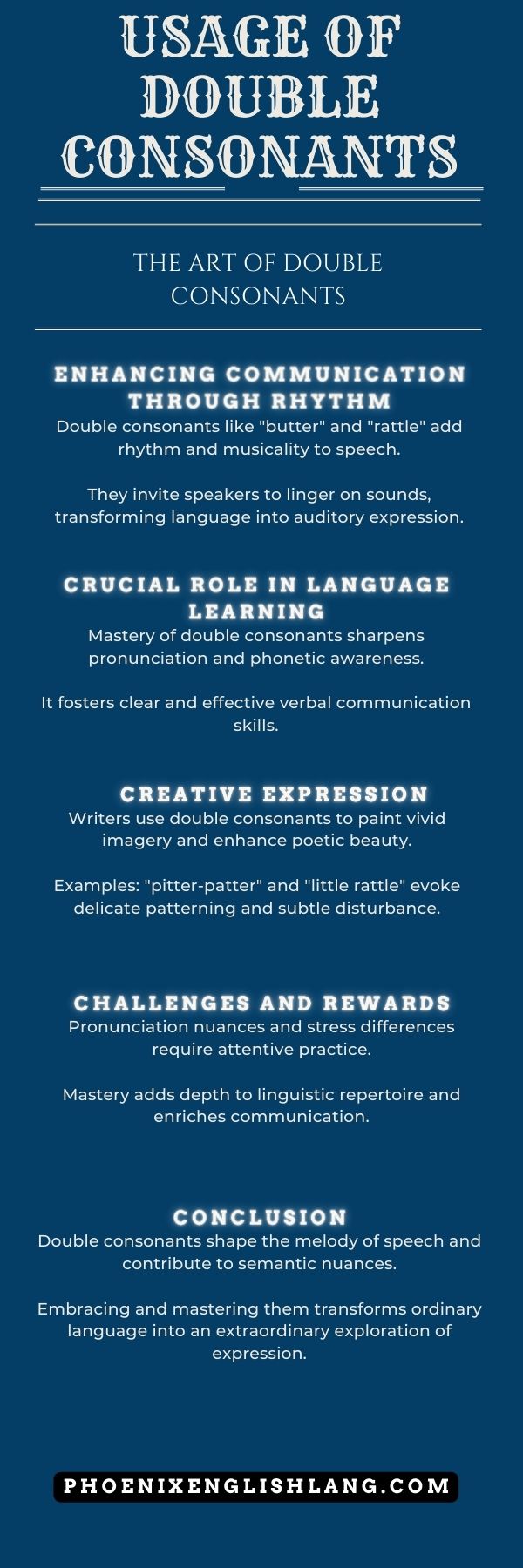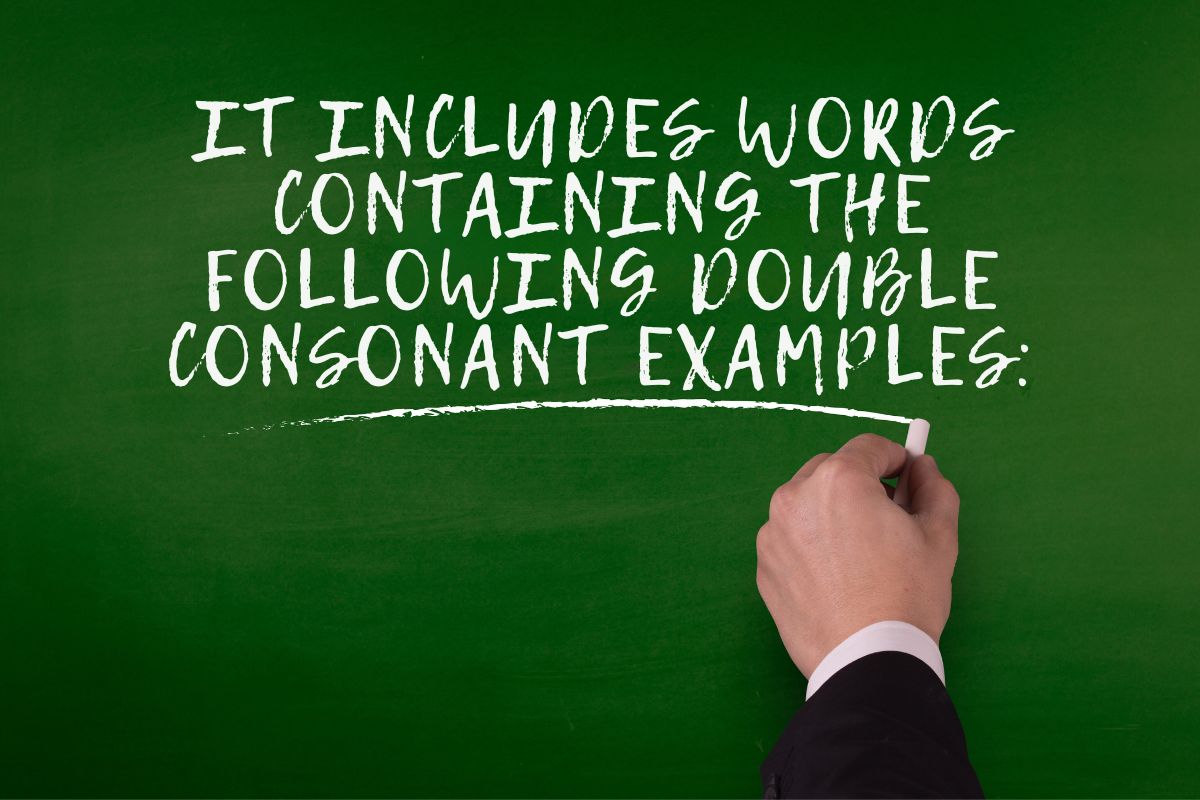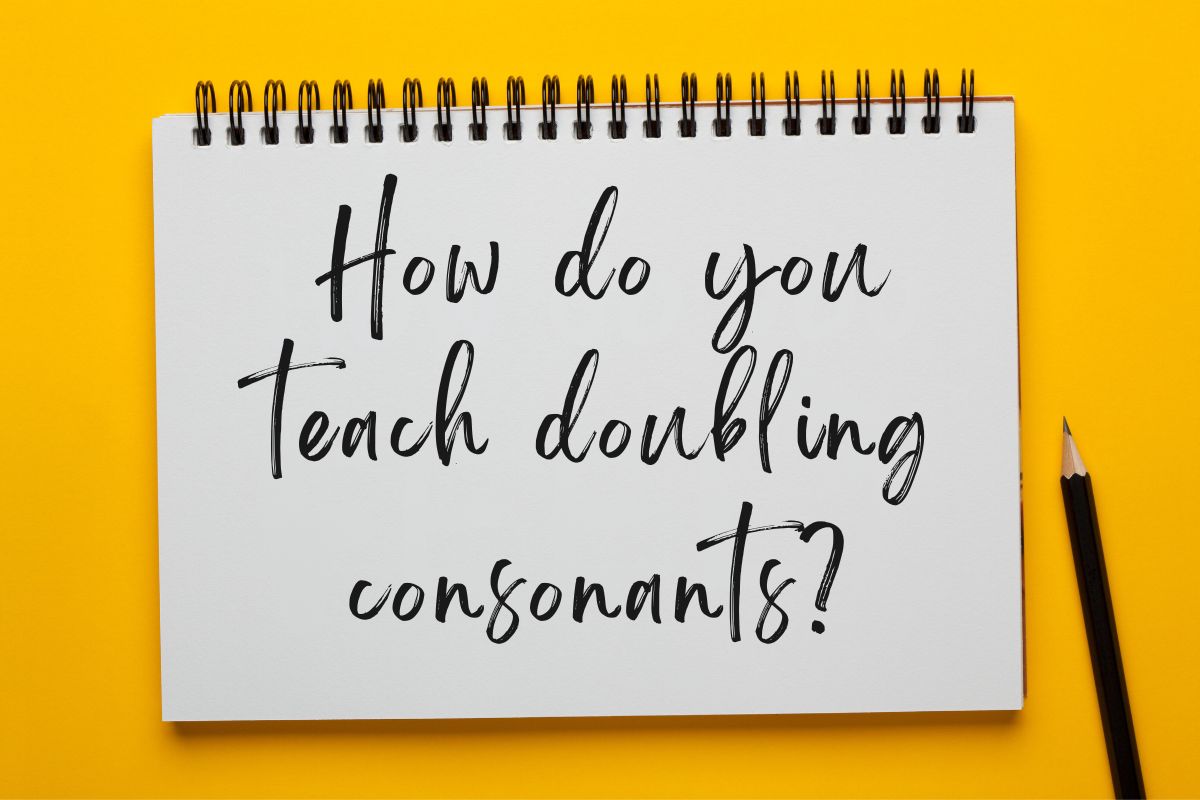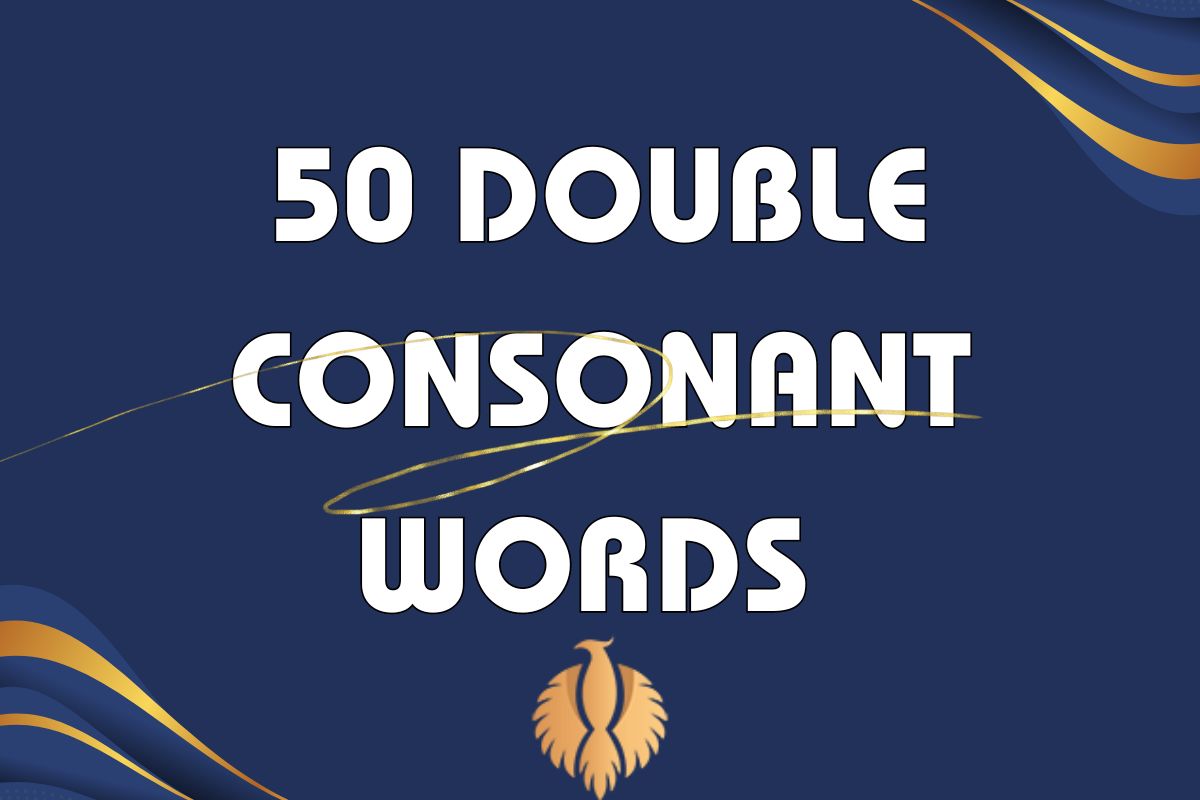Double consonant words are those that contain two consecutive consonant letters. These words are interesting because the presence of double consonants affects their pronunciation and can change their meaning or grammatical function.
Understanding and using double consonant words correctly is essential for effective communication in various languages.
One common category of double consonant words is those that end in -ing, such as running, swimming, or jumping.
The double consonant in these words indicates that the preceding vowel is short. For example, the word “running” is pronounced with a short “u” sound, while the word “runing” without the double consonant would be pronounced with a long “u” sound.
This distinction is important for maintaining the correct tense and meaning in sentences.
Another category of double consonant words is those that have a stressed syllable followed by a consonant and then a vowel.
Examples of these words include letter, better, and dinner. The double consonant in these words serves to indicate that the preceding vowel is short and that the stress falls on the syllable before the double consonant.
Without the double consonant, the pronunciation and meaning of these words would change.
Double consonant words also play a role in English spelling rules. In many cases, words with a short vowel sound followed by a single consonant and then a vowel have a double consonant when forming the past tense or the present participle.
For instance, the word “stop” becomes “stopped” in the past tense and “stopping” in the present participle. This doubling of the consonant helps to maintain the correct pronunciation and grammatical form of the word.
Furthermore, double consonant words can be used to create emphasis or convey a specific meaning. For example, the word “hopping” can refer to the action of jumping lightly, while “hopping” with a double consonant can imply a more vigorous or energetic movement.
Similarly, the word “bitter” describes a strong taste, while “biter” without the double consonant could refer to someone who bites. The presence of the double consonant in these words helps to differentiate their meanings and convey specific nuances.
Therefore, double consonant words are an important aspect of language and communication. They affect pronunciation, grammatical form, and meaning in various languages.
Understanding and using double consonant words correctly is crucial for effective communication and ensures that the intended message is conveyed accurately.
Whether it’s in spelling, tense formation, or conveying emphasis, double consonant words play a significant role in language and should be used appropriately to enhance communication.
Double consonant words add a layer of intricacy to the English language, creating a symphony of sounds that require a keen ear and precise articulation.
These words, where the same consonant appears consecutively, contribute not only to the richness of vocabulary but also play a significant role in phonetic diversity.
The repetition of consonants in words serves various linguistic purposes. It can influence pronunciation, accentuation, and even the meaning of a word.
Consider the simple yet impactful word “better.” The doubling of the ‘t’ not only alters the pronunciation but also distinguishes it from its counterpart “bet,” showcasing how a subtle change can carry significant semantic weight.
Usage of Double Consonants

The artful use of double consonants contributes to the rhythm and cadence of spoken language. Words like “butter,” “rattle,” or “happy” draw attention to the particular consonant, inviting speakers to linger momentarily on the sound and creating a musicality in everyday conversation.
This rhythmic element can transform language into a form of auditory expression, enhancing communication beyond mere words.
Moreover, the presence of double consonants plays a crucial role in language learning and literacy.
For learners, mastering the pronunciation of words with double consonants is an exercise in articulatory precision. It sharpens phonetic awareness and fosters the development of clear and effective verbal communication skills.
In the realm of creative expression, double consonants offer writers a palette of sounds to paint vivid imagery. Poets, in particular, often leverage the rhythmic quality of double consonants to enhance the sonorous beauty of their verses.
Consider the resonant repetition in lines like “pitter-patter” or “little rattle,” where the doubled consonants evoke a sense of delicate patterning or subtle disturbance.
However, mastering double consonant words can pose a challenge, especially for language learners and those developing literacy skills. The subtleties of pronunciation, the nuanced differences in stress, and the impact on meaning require attentive practice and exposure to varied linguistic contexts.
The world of double consonant words is a linguistic playground, inviting speakers and writers to explore the rich tapestry of sounds embedded in the English language.
These words go beyond mere phonetics; they shape the melody of speech, contribute to semantic nuances, and serve as both a challenge and an artistic tool in the grand symphony of language.
Embracing and mastering these double consonants adds depth to one’s linguistic repertoire, transforming the ordinary into an extraordinary exploration of the spoken and written word.
You might also enjoy: Top 50 Commonly Used English Words That End in SE
Must-know 50 double English Consonants
-
- Add:
– Meaning: To Join something to something Else.
– Example:
– Please add sugar to your coffee.
- Ball:
– Meaning: A round object used in games and sports.
– Examples:
– She threw the ball to her dog.
– We went to the park to play with a soccer ball.
- Call:
– Meaning: To shout out or to make a phone call.
- Doll:
– Meaning: A toy figure, especially one in the shape of a human.
– Examples:
– She received a beautiful doll for her birthday.
– The child played with her doll all day.
- Egg:
– Meaning: An oval or round object laid by birds, often eaten as food.
– Examples:
– I like to have scrambled eggs for breakfast.
– The hen laid a large egg today.
- Fall:
– Meaning: To drop down from a higher place.
- Gull:
– Meaning: A type of bird commonly found near the sea.
– Examples: ⌨️
– We saw a gull flying over the beach.
– The gull squawked as it flew over the water.
- Hall:
– Meaning: A large room or corridor in a building.
– Examples:
– We gathered in the hall for the ceremony.
– The hall was decorated with beautiful flowers.
- Inn:
– Meaning: A small hotel, often in a rural area.
– Example:
– The inn was cozy and welcoming.
- Jazz:
– Meaning: A genre of music characterized by improvisation and strong rhythms.
– Examples:
– She loves to listen to jazz music in the evenings.
– The jazz band played beautifully at the festival.
- Kill:
– Meaning: To cause the death of a living being.
– Examples:
– The hunter did not intend to kill the deer.
– This medicine can kill harmful bacteria.
- Lull:
– Meaning: To calm or send to sleep, often by soothing sounds.
– Examples:
– The gentle music helped to lull the baby to sleep.
– I tried to lull my fears with positive thoughts.
- Mill:
– Meaning: A Building equipped with machinery for grinding grain into flour.
– Examples:
– The old mill by the river is now a museum.
– They built a new mill to increase production.
- Nunn:
– Meaning: A Female member of a religious community.
– Examples:
– The nuns dedicated their lives to helping others.
– She decided to become a nun after her education.
- Odd:
– Meaning: Strange or unusual.
– Examples:
– It’s odd to see snow in summer.
– He had an odd habit of collecting rocks.
- Puff:
– Meaning: To blow out air or smoke in a short burst.
– Examples:
– The dragon would puff smoke out of its nostrils.
– She took a puff of her inhaler before the run.
- Quill:
– Meaning: The pen-like spine of a porcupine or a writing tool made from such a spine.
– Example:
– The porcupine’s quills are its defense mechanism.
- Ruff:
– Meaning: A collar of feathers or a type of dog.
– Examples:
– The dog had a fluffy ruff around its neck.
– The bird displayed its ruff during mating season.
- Sill:
– Meaning: The horizontal piece of wood or stone at the bottom of a window or door.
– Examples:
– She placed a plant on the window sill.
– The old house had a cracked sill that needed repair.
It includes words containing the following double consonant examples

Double consonants add a distinct flavor to words, both in terms of pronunciation and meaning. Here are some examples of words with various double consonants:
1. Better
The doubled ‘t’ alters the pronunciation and sets it apart from “bet.”
2. Foggy
The double ‘g’ contributes to the soft, lingering sound in this descriptive term.
3. Rattle
The double ‘t’ emphasizes the quick, sharp sound that a rattling object might make.
4. Address
The double ‘d’ highlights the syllabic separation and adds clarity to this commonly used word.
5. Commit
The double ‘m’ reinforces the idea of dedication or adherence to a particular action.
6. Happily
The double ‘p’ adds a rhythmic quality to this adverb, expressing a joyful sentiment.
7. Little
The double ‘t’ brings attention to the diminutive nature of the described object.
8. Accommodate
The double ‘m’ in this longer word helps maintain the syllabic balance and aids in pronunciation.
9. Ballet
The double ‘l’ contributes to the graceful and flowing sound associated with this form of dance.
10. Committee
The double ‘t’ and ‘e’ in this word emphasize collaboration and joint decision-making.
Understanding and correctly pronouncing words with double consonants enhance linguistic skills, allowing for effective communication and a nuanced appreciation of the English language.
What is a double consonant word examples ?
Here are some examples of words with double consonants:
- Address
- Better
- Commit
- Foggy
- Rattle
- Little
- Happily
- Accommodate
- Ballet
- Committee
These words showcase various instances of double consonants, where the same consonant appears consecutively, contributing to their pronunciation and, in some cases, altering their meanings.
How do you teach doubling consonants?

Teaching the concept of doubling consonants involves a combination of visual, auditory, and kinesthetic strategies to help learners grasp the rule and apply it effectively. Here are some steps you can take:
1. Introduce the Concept
– Begin by explaining the concept of doubling consonants. Emphasize that certain words have double consonants to indicate a specific sound or meaning.
2. Provide Examples
– Share examples of words with double consonants, illustrating how the doubling affects pronunciation and meaning. Use visuals or real-life objects to reinforce understanding.
3. Highlight Pronunciation:
– Practice pronouncing words with and without double consonants. Draw attention to the difference in sound, emphasizing the sharper or longer pronunciation when a consonant is doubled.
4. Word Sorting Activities
– Engage learners in word sorting activities where they categorize words into those with double consonants and those without. This hands-on approach helps reinforce the visual recognition of patterns.
5. Interactive Games
– Incorporate interactive games or online activities that focus on words with double consonants. This could include puzzles, quizzes, or matching games to make learning engaging.
6. Reading Exercises
– Provide reading exercises with sentences or short passages containing words with double consonants. Encourage learners to identify and pronounce these words accurately within the context of sentences.
7. Spelling Practice
– Implement spelling practice using words with double consonants. Encourage learners to write these words multiple times to reinforce the correct spelling pattern.
8. Creative Writing
– Integrate double consonant words into creative writing exercises. Prompt learners to use words with double consonants in their own sentences, fostering both understanding and application.
9. Mnemonic Devices
– Introduce mnemonic devices or catchy phrases to help learners remember the rules associated with doubling consonants. For example, “Commit the ‘t’ to memory when doubling.”
10. Provide Feedback
– Offer constructive feedback during activities and assessments. Correct pronunciation and spelling errors, and encourage learners to ask questions if they need clarification.
By incorporating a variety of teaching methods and making the learning experience interactive and enjoyable, you can help students understand and remember the rules associated with doubling consonants.
Consistent practice and reinforcement are key elements in mastering this linguistic concept.
You might also enjoy: Top 25 most used words with suffix less
What words end in double consonants?
Many words end with double consonants, and these can vary based on pronunciation, origin, and usage. Here are some examples:
- better
- letter
- dinner
- ladder
- butter
- happy
- coffee
- fuzzy
- rattle
- little
- ballet
- madder
- add
- jazz
- fluff
- quell
- gull
- staff
- doll
- offend
These words demonstrate instances where the same consonant appears consecutively at the end, contributing to the pronunciation and often altering the meaning of the word.
How do you find the double consonant?
Identifying double consonants in a word involves recognizing instances where the same consonant appears consecutively. Here’s a step-by-step guide to finding double consonants:
1. Read the Word Aloud
– Pronounce the word carefully, paying attention to each consonant sound.
2. Look for Repeated Consonants
– Examine the word for consecutive consonant letters. If you notice the same consonant appearing two times in a row, it indicates a double consonant.
3. Check for Vowels in Between
– Ensure that there are no vowels separating the repeated consonants. Double consonants involve the immediate repetition of the same consonant sound.
4. Consider Pronunciation
– Think about the pronunciation of the word. Does the repetition of the consonant create a distinct sound or affect the word’s rhythm?
5. Consult a Dictionary
– If you’re uncertain, consult a dictionary. Many dictionaries provide pronunciation guides, and they often indicate double consonants in the spelling.
6. Learn Common Patterns
– Familiarize yourself with common patterns of double consonants, such as ‘tt,’ ‘ll,’ ‘ss,’ and ‘ff.’ These patterns often appear in English words.
7. Practice Recognition
– Engage in activities like reading and spelling exercises that involve words with double consonants. Regular practice enhances your ability to recognize them.
For example, in the word “better,” the double consonant ‘tt’ is evident. Similarly, in “happy,” the ‘pp’ represents a double consonant. By applying these steps and practicing regularly, you can become adept at identifying double consonants in words.
Teaching CVC words ending in double consonants

Teaching CVC (consonant-vowel-consonant) words ending in double consonants can be an engaging and effective way to reinforce phonics skills. Here’s a step-by-step guide:
| 1. Introduction: |
| – Start by explaining the concept of CVC words and their importance in early reading. Emphasize that CVC words follow a simple pattern of a consonant, followed by a vowel, and ending with another consonant. |
| 2. Define Double Consonants: |
| – Introduce the idea of double consonants by explaining that sometimes the final consonant in a CVC word is repeated. This repetition affects both the pronunciation and the meaning of the word. |
| 3. Examples: |
| – Provide examples of CVC words ending in double consonants. For instance: |
| – hop → hopper |
| – run → runner |
| – big → bigger |
| – Pronounce these words together, highlighting the repeated consonant sound at the end. |
| 4. Visual Aids: |
| – Use visuals, such as flashcards or illustrations, to represent CVC words ending in double consonants. This helps make the concept more tangible for learners. |
| 5. Hands-On Activities: |
| – Engage students in hands-on activities like building words using letter tiles or cards. Allow them to physically see and manipulate the letters to create CVC words with double consonants. |
| 6. Reading Exercises: |
| – Incorporate reading exercises that feature CVC words ending in double consonants. Use simple texts or create short sentences to practice these words in context. |
| 7. Word Sorting: |
| – Conduct word sorting activities where students categorize words into those with double consonants at the end and those without. This helps reinforce visual recognition. |
| 8. Rhyming Games: |
| – Play rhyming games with CVC words ending in double consonants. Encourage students to find words that rhyme and identify the repeated consonant sound. |
| 9. Creative Writing: |
| – Integrate CVC words ending in double consonants into creative writing exercises. Prompt students to use these words to create their own sentences or short stories. |
| 10. Repetition and Reinforcement: |
| – Emphasize the importance of repetition for reinforcement. Encourage regular practice through various activities to solidify understanding. |
| 11. Assessment: |
| – Assess students’ progress through quizzes, reading assessments, or simple assignments that require them to apply their knowledge of CVC words ending in double consonants. |
| 12. Encourage Reading Aloud: |
| – Foster confidence and fluency by encouraging students to read aloud, emphasizing the double consonant sounds in the words they encounter. |
By incorporating a variety of activities and making the learning experience interactive, you can effectively teach CVC words ending in double consonants and provide a solid foundation for early reading skills.
You might also enjoy: Full List Of Words That Start With Bi + Examples [2024]
How do you know if a word has double letters?
To determine if a word has double letters, you can follow these steps:
| 1. Read the Word Aloud: |
| – Pronounce the word carefully, paying attention to each letter’s sound. |
| 2. Look for Repeated Letters: |
| – Examine the word for consecutive instances of the same letter. If you see the same letter appearing two or more times in a row, it indicates double letters. |
| 3. Check for Vowels in Between: |
| – Ensure that there are no vowels separating the repeated letters. Double letters involve the immediate repetition of the same letter sound. |
| 4. Consider Pronunciation: |
| – Think about the pronunciation of the word. Does the repetition of the letter create a distinct sound or rhythm? |
| 5. Consult a Dictionary: |
| – If you’re uncertain, consult a dictionary. Most dictionaries provide pronunciation guides, and they often indicate double letters in the spelling. |
| 6. Learn Common Patterns: |
| – Familiarize yourself with common patterns of double letters, such as ‘ss,’ ‘ll,’ ‘tt,’ and ‘pp.’ These patterns frequently appear in English words. |
For example, in the word “address,” the double letter ‘d’ is evident. Similarly, in “happy,” the double letter ‘p’ represents a repeated consonant sound. Practicing these steps regularly will help you identify words with double letters more easily.
What is an example of double consonant in a sentence?
Certainly! Here’s an example of a sentence with a double consonant:
“The little rabbit hopped across the grass, leaving tiny footprints.”
In this sentence, the word “little” contains a double consonant ‘t,’ and the word “footprints” contains a double consonant ‘t’ as well. The repetition of the consonant contributes to the pronunciation and overall rhythm of the words.
Which consonants never double?

In English, certain consonants generally do not double in the middle or at the end of words. These consonants are:
1. Vowels:
Vowels themselves are not consonants, but it’s worth noting that they also do not double. For example, you won’t find double ‘a,’ ‘e,’ ‘i,’ ‘o,’ or ‘u’ in standard English spelling.
2. C, Q, X, and J:
These consonants are less likely to double in English. You will seldom see words where ‘c,’ ‘q,’ ‘x,’ or ‘j’ double, especially in common words.
It’s important to note that while these consonants typically do not double, there may be exceptions, especially in borrowed words, proper nouns, or technical terms.
Additionally, the rules of spelling can vary based on language origin and individual word forms. Always refer to specific words or language rules for accurate spelling.

Hi, welcome to my blog! My name is Omid and I am thrilled to have you here! I am an English language teacher with 12 years of experience and hold multiple international certifications (TESOL, IELTS, TOEFL, PTE, CELTA). Additionally, I hold a PhD in Applied Linguistics with a specialization in Teaching English as a Second Language (TESL), which fuels my passion for teaching English and assisting others in mastering the language. To me, nothing is more rewarding than helping individuals enhance their English language abilities through various methods. So, let’s embark on this journey of learning English together.




